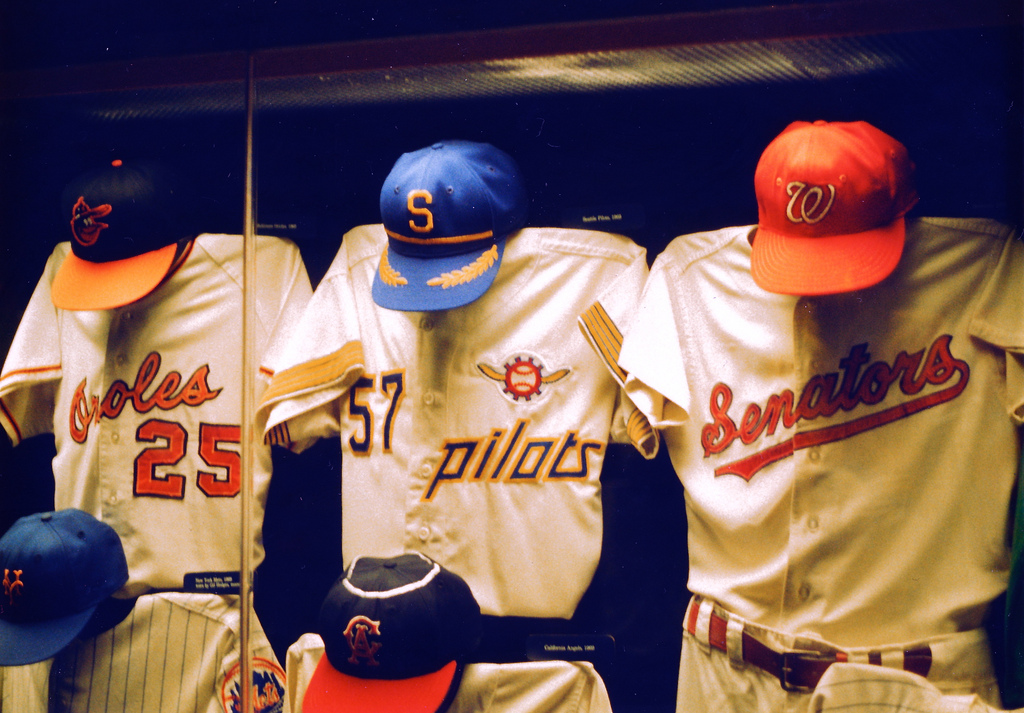The baseball uniform, like the game itself, has seen a lot of changes in its lifetime: changes for comfort, changes for safety, and changes to reflect colorful times in the nation’s history. All these changes have played a part in shaping what is today an iconic look. The uniform is as much a symbol of the game as the baseball itself.
The 19th Century
The basics of the uniform were all there from the beginning: a hat, a shirt, and pants. But it was a few years before they took on a stylized design. In 1849, the first organized baseball club, the New York Knickerbockers, played in blue wool pantaloons, a white flannel shirt, and a straw hat called a chip, according to the National Baseball Hall of Fame. Caps were adopted a few years later.
The next major change came along in 1868. Ballplayers had always had trouble with the long pantaloons, with many taking creative steps to keep their pant legs out of the way while playing. These efforts included tying belts around their ankles and using tapered pants secured with buttons.
Finally, the Cincinnati Red Stockings took a cue from the game of cricket and began wearing knee-length knickers. Other teams quickly followed suit, creating a look that lasted for over a century.

The Early 20th Century
The first decades of the 1900s brought several innovations. Prior to 1905, most baseball shirts were collared. The 1906 New York Giants were the first team to introduce a jersey without a collar, and by 1914 every other team in the Major Leagues would be collarless, according to the Baseball Hall of Fame.
In 1916, the Cleveland Indians became the first team to wear numbered jerseys, with the number located on their left sleeves. The practice only lasted a few weeks. In 1923, the St. Louis Cardinals added numbers to their sleeves, but due to “embarrassment,” they quickly abandoned them. In 1929, the Indians introduced numbers to the backs of their jerseys. Although the New York Yankees are credited with the idea, a rainout in New York meant Cleveland was the first to wear them on the field.
The Mid-20th Century
The Chicago Cubs are credited with two uniform innovations. The first was the zippered uniform, introduced in 1937. By 1940, half the clubs in the Majors had swapped buttons for zippers. In 1940, the Cubs introduced the sleeveless jersey, a flannel vest worn over an undershirt. While the team only wore them for three years, the look caught on. Sleeveless jerseys fell out of favor in the early 1970s but were revived in the early 1990s.
In 1952, the Brooklyn Dodgers became the first team to wear numbers on the fronts of their uniforms. And in 1960, the Chicago White Sox became the first team to add player names to the backs of their jerseys, likely due to the rise of televised games.
The Late 20th Century
The most influential look of the era began in 1970, when the Pittsburgh Pirates, upon moving to a new stadium, decided to wear new uniforms: cotton-nylon blend pullover shirts and beltless pants. The look was quickly adopted by the majority of Major League teams. It lasted until 1987, when several teams decided to move back to a traditional look featuring button-up jerseys and belted pants. The Reds were the last team to wear the pullover uniforms, abandoning them in 1993.
Byline
Marcus Benson is a freelance writer and avid sports fan; he enjoys writing on sports history, sports statistics, trends in sports and so forth. Those interested in looking at current sports attire should visit Lupo Sports.
Image credit goes to Piedmont Fossil.
